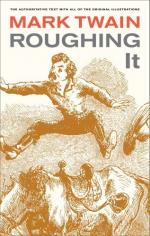He was dressed entirely in black—dress-coat and silk hat—and looked rather democratic in the midst of the showy uniforms about him. On his breast he wore a large gold star, which was half hidden by the lapel of his coat. He remained at the door a half hour, and occasionally gave an order to the men who were erecting the kahilis [Ranks of long-handled mops made of gaudy feathers—sacred to royalty. They are stuck in the ground around the tomb and left there.] before the tomb. He had the good taste to make one of them substitute black crape for the ordinary hempen rope he was about to tie one of them to the frame-work with. Finally he entered his carriage and drove away, and the populace shortly began to drop into his wake. While he was in view there was but one man who attracted more attention than himself, and that was Harris (the Yankee Prime Minister). This feeble personage had crape enough around his hat to express the grief of an entire nation, and as usual he neglected no opportunity of making himself conspicuous and exciting the admiration of the simple Kanakas. Oh! noble ambition of this modern Richelieu!
It is interesting to contrast the funeral ceremonies of the Princess Victoria with those of her noted ancestor Kamehameha the Conqueror, who died fifty years ago—in 1819, the year before the first missionaries came.
“On the 8th of May, 1819, at the age of sixty-six, he died, as he had lived, in the faith of his country. It was his misfortune not to have come in contact with men who could have rightly influenced his religious aspirations. Judged by his advantages and compared with the most eminent of his countrymen he may be justly styled not only great, but good. To this day his memory warms the heart and elevates the national feelings of Hawaiians. They are proud of their old warrior King; they love his name; his deeds form their historical age; and an enthusiasm everywhere prevails, shared even by




